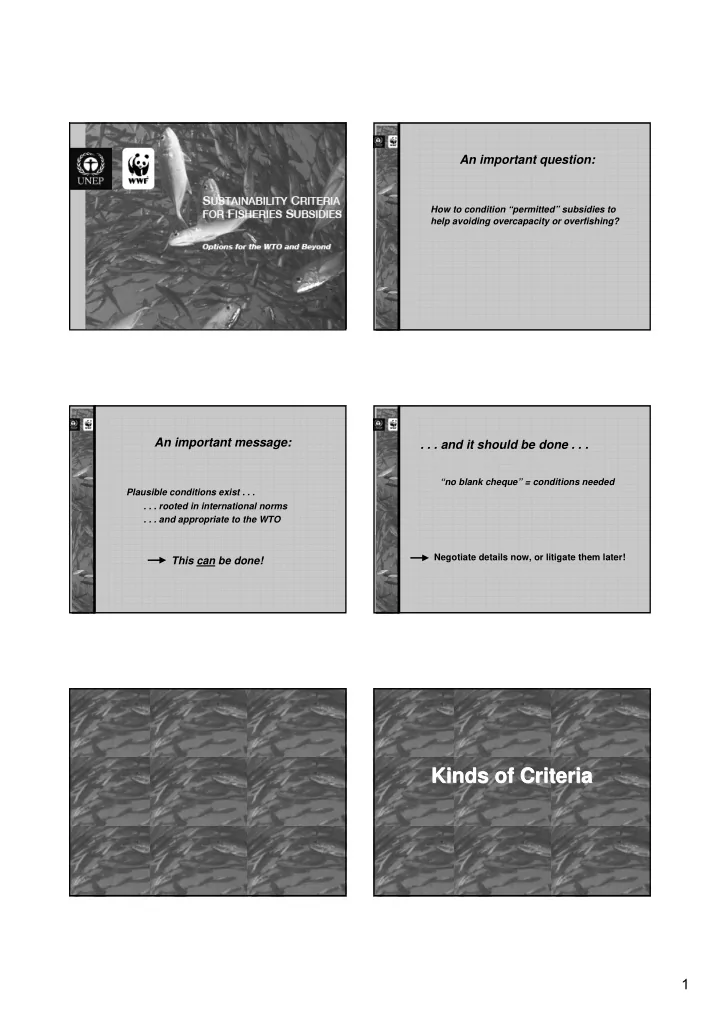

An important question: How to condition “permitted” subsidies to help avoiding overcapacity or overfishing? An important message: . . . and it should be done . . . “no blank cheque” = conditions needed Plausible conditions exist . . . . . . rooted in international norms . . . and appropriate to the WTO Negotiate details now, or litigate them later! This can be done! Kinds of Criteria Kinds of Criteria Kinds of Criteria 1
Meta-Criteria Three Levels of Ambition • Specific – concrete, unambiguous • “Best Practices” = what really should be done • Effective – predictive of outcomes • Acceptable – rooted in international norms • “Minimum Recommended Conditions” • Plausible – in reach for all stakeholders = the least governments should do • Consistent – should reinforce each other • “Minimum International Requirements” • Appropriate – in various contexts = what the WTO should require Three Categories of Criteria An important caveat . . . • Biological Even “best practices” cannot guarantee = can the stock withstand more fishing? “sustainable” fisheries subsidies • Industrial Criteria for use in WTO even less so . . . = does the fleet have “room to grow”? These criteria only reduce risks where other policy goals (such as • Regulatory S&DT) require risks to be taken = is the fishery adequately managed? Minimum Minimum Best Practices Recommended International The answers for the WTO are Conditions Requirements relatively simple . . . Stock Health (biological) WTO Fleet Capacity . . . getting to them is not (industrial) Fisheries → the following is an overview of conclusions only Management (regulatory) 2
The Overall Solution 1. Limit subsidies to fisheries where stocks are underexploited and fleets are undercapacity. Building Blocks of a Building Blocks of a Building Blocks of a 2. Require management consistent with the WTO Solution WTO Solution WTO Solution UN Code of Conduct. 3. Articulate criteria for minimum management. 4. Adjust criteria for “artisanal fisheries”. Stock Health 1. Adopt FAO vocabulary and require “underexploited”: Stock Health Stock Health Stock Health ”Undeveloped or new fishery, believed to have a significant + + + potential for expansion in total production” Fleet Capacity Fleet Capacity Fleet Capacity 2. Base on MSY + precaution 3. Do not require quantification of “underexploited” Fleet Capacity Levels 1. Define “full capacity” as capacity required to fish at MSY + precation Management Management- -Related - Related Related Management 2. Require capacity assessment (see below) Criteria Criteria Criteria 3. Set highly precautionary limit for subsidies, preferably quantitative (e.g., 50% full capacity) 3
Elements of Management Explicit reference to Code of Conduct is a good idea ... ... perhaps even make this the core obligation ... 1. Assessment of stocks and fleets . . . but . . . 2. Regulatory control of fishing and capacity Give strong consideration to articulating basic elements 3. Surveillance and enforcement of limits - for clarity - to avoid undue litigation First step for WTO = Explicitly require all three - to limit reach of WTO rules then say what is concretely required . . . Stock Assessment What kind to require? . . . options include: scientific survey → expensive! (1) Assessment (1) Assessment (1) Assessment fisheries dependent (e.g., catch data) indirect (e.g., cost trends) → weak indicators informal / anecdotal → non-quantitative • required by international norms • widely used • data collection is part of surveillance/control Capacity Assessment Require stock assessments that are: What kind to require? . . . options include: – “science-based” scientific survey → expensive and complex! – quantitative indirect (e.g., cost trends) – based at least on catch data crude inventories (e.g., counting boats) informal / anecdotal → non-quantitative + Require all vessels in subsidized fishery to report catches • can produce rough quantitative estimates • data often collected or available 4
Require fleet assessments that are: – “science-based” (2) Control (2) Control (2) Control – quantitative “to maximum reasonable extent” – based on best available data + Require all vessels in subsidized fishery to be registered (note int’l norm + FAO data requirements) “Control” = planning + setting limits “recommended” and “best” practices would require more, e.g. : Basic requirements: – Preset mandatory responses to hitting target – formal management plan reference points . . . including capacity plan per IPOA-Capacity – quantitative “target reference points” – Threshold reference points specifically for use – aimed at MSY + precautionary margin of subsidies – legally binding limits, including mandatory fishing licenses Effective enforcement is: - basic to good management - explicitly required in some international fisheries instruments (3) Enforcement (3) Enforcement (3) Enforcement . . . But, can the WTO require it? 5
Require “reasonable” enforcement: Precedents in WTO and other trade treaties: – laws + mechanisms → rebuttable presumption – contrary finding requires “clear and – TRIPS (Art. 41.1) : convincing” proof of: “ Members shall ensure that enforcement procedures . . . are available under their law so as to permit effective 1. a consistent pattern of illegal activity having biologically action against any act of infringement . . .” [or commercially] significant impacts 2. an “unreasonable inattention” to enforcement activities – Some regional & bilateral agreements, starting + withdraw subsidies to enterprises with NAFTA engaged in IUU fishing Treatment of Artisanal Fisheries 1. Stocks and fleets assessed via informal, non- quantitative methods 2. There is a “reasonable basis to conclude that the target stocks are underexploited and the fleets are at substantially less than full capacity” Artisanal Fisheries Artisanal Fisheries Artisanal Fisheries 3. There is a formal management plan aimed at MSY + precaution 4. There are (in place are being developed) community- based mechanisms to control fishing 5. Subsidized increases in capacity or effort are carefully monitored and recorded 6. Proportional investments in management + “continuous improvements” 6
Recommend
More recommend